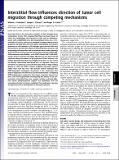Interstitial flow influences direction of tumor cell migration through competing mechanisms
Author(s)
Charest, Joseph L.; Polacheck, William Joseph; Kamm, Roger Dale
DownloadPolacheck-2011-July-Interstitial flow in.pdf (878.1Kb)
PUBLISHER_POLICY
Publisher Policy
Article is made available in accordance with the publisher's policy and may be subject to US copyright law. Please refer to the publisher's site for terms of use.
Terms of use
Metadata
Show full item recordAbstract
Interstitial flow is the convective transport of fluid through tissue extracellular matrix. This creeping fluid flow has been shown to affect the morphology and migration of cells such as fibroblasts, cancer cells, endothelial cells, and mesenchymal stem cells. A microfluidic cell culture system was designed to apply stable pressure gradients and fluid flow and allow direct visualization of transient responses of cells seeded in a 3D collagen type I scaffold. We used this system to examine the effects of interstitial flow on cancer cell morphology and migration and to extend previous studies showing that interstitial flow increases the metastatic potential of MDA-MB-435S melanoma cells [Shields J, et al. (2007) Cancer Cell 11:526–538]. Using a breast carcinoma line (MDA-MB-231) we also observed cell migration along streamlines in the presence of flow; however, we further demonstrated that the strength of the flow as well as the cell density determined directional bias of migration along the streamline. In particular, we found that cells either at high seeding density or with the CCR-7 receptor inhibited migration against, rather than with the flow. We provide further evidence that CCR7-dependent autologous chemotaxis is the mechanism that leads to migration with the flow, but also demonstrate a competing CCR7-independent mechanism that causes migration against the flow. Data from experiments investigating the effects of cell concentration, interstitial flow rate, receptor activity, and focal adhesion kinase phosphorylation support our hypothesis that the competing stimulus is integrin mediated. This mechanism may play an important role in development of metastatic disease.
Date issued
2011-06Department
Massachusetts Institute of Technology. Department of Biological Engineering; Massachusetts Institute of Technology. Department of Mechanical EngineeringJournal
Proceedings of the National Academy of Sciences
Publisher
Proceedings of the National Academy of Sciences (PNAS)
Citation
Polacheck, W. J., J. L. Charest, and R. D. Kamm. “Interstitial flow influences direction of tumor cell migration through competing mechanisms.” Proceedings of the National Academy of Sciences 108.27 (2011): 11115-11120. Web. 1 Feb. 2012.
Version: Final published version
ISSN
0027-8424
1091-6490